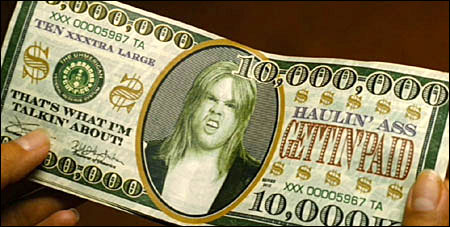
I believe that all government-manufactured crises are just that.
Therefore, the so-called threat of counterfeiting is quite small and limited despite the breathless Secret Service pronouncements (that is, when they aren’t chasing South American hookers).
Newfangled bills are a make-work for everyone from equipment makers to print operators to the PR department to, as always, the bored, lazy, pro-government media who will put the new notes on the front page...because half of America hasn’t seen a real $100 in a while since they rely on EBT.
Two points:
1) if counterfeiting on a grand scale were a problem then they wouldn’t publicize it since it would devalue the currency through word of mouth.
2) how bad is any physical counterfeiting versus the government’s own quantitative easing, which devalues the dollar with the press of a key as billions of virtual dollars are pumped into an already inflated bubble?
Meant to say #2 agrees with your point
Sorry, I only deal in Euros.
Pretty soon their will be bills only good for a few months, red, gree, blue....
Taken from one of Matt Brackens novels.
Pretty soon their will be bills only good for a few months, red, gree, blue....
Taken from one of Matt Brackens novels.

My take is a bit different. The US has long had one of the least colorful currencies. A little pizazz in the design is fine as long as it doesn’t invalidate the old notes.
Looking forward, if the hyperinflation I fear ever materializes, and the notes become worthless, I will turn them into laminated bookmarks. I already have some laminated bookmarks made from Peruvian and Hungarian currencies. I like my bookmarks to be aesthetically pleasing—and the new design may help in that regard. /S
Last time I handled a C-note was during the “worst economy since the depression” of the Bush administration.
I do handle a lot of change now...
Tried to get one from a TD bank in South Jersey yesterday and they told me they didn’t have any yet !

If you wait to be paid in gold, I think your business may fail.
Where is the expiration date?

Truthfully, in future I imagine an end to currency paper which is composed of 75% cotton and 25% linen (from flax), in favor of much more durable hemp paper currency, possibly reinforced with polymers such as polyester.
100% hemp fabric has 62% greater tear strength and 102% greater tensile strength than cotton. Polyester is even stronger.
A very big, but hidden problem with the dollar is a perpetual shortage of paper currency, with existing supplies only large enough to back 4% of US daily retail trade. The Bureau of Engraving and Printing (BEP) prints mostly $1 bills, which have a typical lifespan of six months. They also print proportionately fewer higher denomination bills.
If bills lasted longer, a year or more, over decades the amount of paper currency in the economy would slowly increase, assuming our virtual currency didn’t experience reckless inflation.
The unusual feel of currency today, from the cotton linen blend, would be just as unusual with a hemp and synthetic blend, as refined hemp has a silky feel, and looks much like silk.
Another big advantage is that hemp can grow in marginal farmland, with little irrigation, fertilizer and pesticide, so would not displace our food farmland.